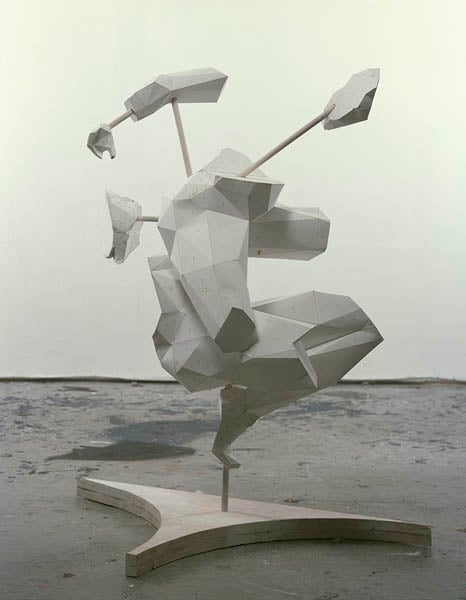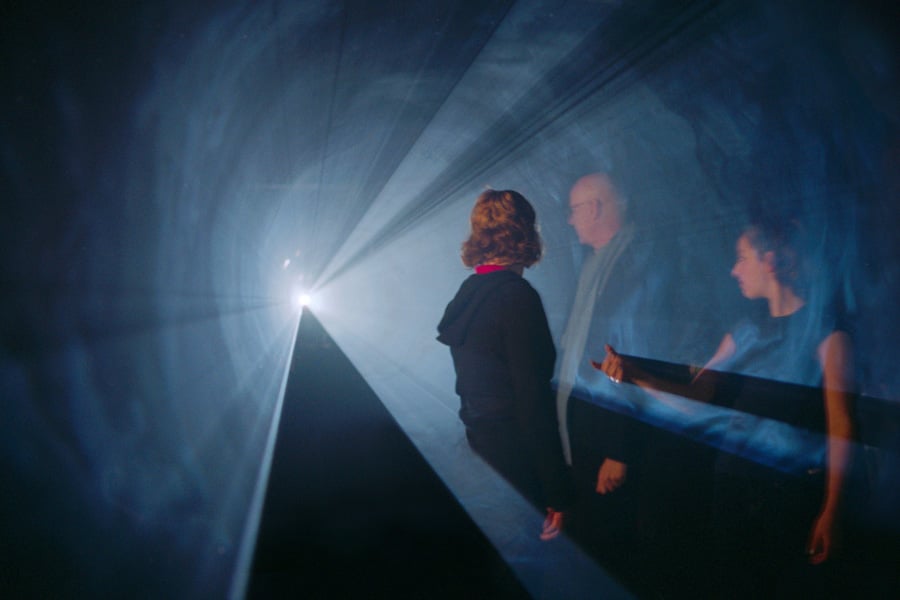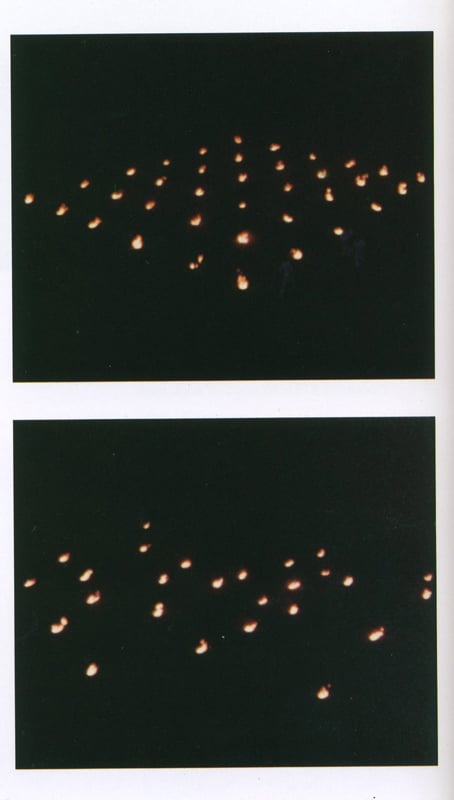
© » KADIST
Wolfgang Tillmans
Wolfgang Tillmans initiated the ongoing series Faltenwurf in 1989, representing compositions of unused clothing, with special attention paid to the ways in which they drape and fold. The title is taken from a Germanic term used in the context of art history, designating classical drapery. In this particular photograph, Faltenwurf (Stairwell) , an assortment of various colored clothes lay tangled on a set of stairs, as a sculpture of abstract forms.

© » KADIST
Toby Ziegler
The Fifth Quarter might have taken its mysterious inspiration from the eponymous Stephen King story collated into the Nightmares & Dreamscapes collection. Various vanishing points and interior perspectives, like in another painting dated the same year called Continental Breakfast , create a complex matrix in which motifs, shadowy or geometric forms coexist to further confuse the map of this space. A disturbing yet alluring virtual reality composed of a medley of seemingly abstract designs is depicted through digital and painterly means.

© » KADIST
Anthony McCall
Drawing & Print (Drawing & Print)
This score is a graphic record of the detailed choreography of one of Anthony McCall’s Landscape for Fire performances. These took place between 1972-74 in the UK at the Museum of Modern Art in Oxford, Colchester School of Art, in Reading and in North Weald as well as in Sweden at Fylkingen Society of Contemporary Music and Arts, Stockholm, and in the USA at the William Patterson University, Wayne, New Jersey. Many of these events were photographed by David Kilburn and Carolee Schneemann, only one in 1972 was filmed.

© » KADIST
Amalia Pica
Memorial for intersections #2 (2013) is a minimalist, black metallic structure that contains the brightly colored translucent circles, triangles, rectangles, and squares that originally were presented in Pica’s performance work A ? B ? C (2013).

© » KADIST
Ximena Garrido Lecca
Destilaciones ( Distillations , 2014) is an installation composed of a group of ceramic pots, presented on the floor and within a steel structure. Copper pipes run through the perforated ceramics, evoking the design of an oil purifier. The work is a direct reference to the history of the Peruvian coastal town of Lobitos.

© » KADIST
Hiraki Sawa
Hako (2006) depicts a mysterious and dystopic landscape where the world becomes flat: distance between different spaces, depth of field and three-dimensional perceptions are canceled. Interiors of a Victorian doll’s house, a rippled seascape, a palm tree forest, and a gravel seashore are superimposed, morphing into each other. The hermetic narrative is charged with psychological and mythological aspects.

© » KADIST
Toby Ziegler
Wagon Wheel is a work with a fundamental dynamism that derives both from the rotating movement of the elements suspended on poles and the kicking of the legs of the figure. It is based on a pornographic image by Giulio Romano (ca.1499-1546). Romano had completed Raphael’s frescos in the Vatican after the latter’s death but was not paid for the work.

© » KADIST
Jeremy Deller
Beyond the White Walls , with a commentary written and spoken by Jeremy Deller, is often wryly amusing. The artist narrates the many projects he has completed or which are in progress beyond the gallery walls. It is beyond the gallery where Deller is at his most effective and where his art reaches out to and into people’s lives.

© » KADIST
Alexandre da Cunha
His Deck Painting I recalls the simplistic stripes of conceptual artist Daniel Buren, or the minimal lines of twentieth century abstract painting, but is in reality a readymade, fashioned from repurposed fabric of deck chairs. Alexandre da Cunha reinvents found objects in surprising ways that combine the material characteristics of Arte Povera with the concerns and techniques of painting. Da Cunha’s work often features flags—either as a found material per se or as a constructed form—that reflect the artist’s interest in issues of nationality, governmental politics, allegiance, and culture.

© » KADIST
Tomoko Yoneda
Yoneda’s Japanese House (2010) series of photographs depicts buildings constructed in Taiwan during the period of Japanese occupation, between 1895 and 1945. Yoneda focuses both on the original Japanese features of the houses and on details that have been altered since the end of the occupation. The yet-to-be acknowledged history of the occupation of Taiwan and other East Asian countries by Japan during World War II is subtly disclosed in these pictures.

© » KADIST
Alexandre da Cunha
Glaze (Savana) (2005) is an assemblage of found materials: a car wheel, a tire, and a wooden plinth of the type traditionally used to display sculpture. It directly engages with the readymade, a subject that Alexandre de Cunha takes up throughout his practice, often inflecting it with a tropical, and South American–inspired materiality and painterly style that could potentially come across as a stereotype. Here, da Cunha transforms the component parts into a composition that highlights often-overlooked materials of artistic production and cultural mass-production.

© » KADIST
Anthony McCall
The film Line Describing a Cone was made in 1973 and it was projected for the first time at Fylkingen (Stockholm) on 30 August of the same year. This piece, which was initially screened in independent film contexts, it soon began to be shown at art museums and ended up becoming one of the key works of the artistic movement that opened up the visual arts towards cinema. With a duration of 30 minutes, the film shows the creation of a white curve being projected onto an empty space.

© » KADIST
Anthony McCall
Landscape for fire is a major work by Anthony McCall. The film recounts a performance where characters in white, light up fires in a very orchestrated choreography of lights in a vast flat landscape. The performance is carefully planned – the fires are lit and geometrically aligned in a precise temporal progression.

© » KADIST
Alexandre da Cunha
In Laissez-Faire (Rainbow Flag) da Cunha has turned a beach towel into both a painting and a flag. Where the printed surface of the towel originally served to enliven this commodity, here the pattern—now stretched and re-presented—suddenly refers to abstract painting’s promises of transcendence. And its crisply painted shape pulls the printed colors into the rectangularity of the canvas and, as da Cunha notes, the graphic iconicity of flags.

© » KADIST
Michael Landy
H.2. N. Y Skeleton of the Dump revolves entirely around the performance “Homage to New York” (1960), of the Swiss artist Jean Tinguely (1925-1991), during which the machine built by the artist in the gardens of the Museum of Modern Art (MOMA) had to self-destruct itself in 27 minutes, but, in the end, it had to be finished off by firemenbeing called in after it erupted in flames. Since the discovery of Jean tinguely’s retrospective at the Tate Gallery in London, in 1982, Michael Landy spent two years researching and sketching (charcoal, oil, glue, ink) from his previous research carried out at Museum Tinguely in Basel, and at the MOMA in New York.

© » KADIST
Cerith Wyn Evans
Untitled (Perfect Lovers + 1) by Cerith Wyn Evans takes as its starting point Felix Gonzales-Torres’s seminal work Untitled (Perfect Lovers) , in which two clocks were synchronized and left to run without interference, the implication being that one would stop before the other. Gonzales-Torres’ original work was a personal allusion to his own partner’s increasingly debilitating HIV-related illness, which grapples with the existential tension of coexistence in the face of death. Cerith Wyn Evans’s piece takes the same concept, and adds a third clock, moving from the intimacy of a monogamous relationship to suggest a more expansive, or possibly polyamorous alternative.

© » KADIST
Alexandre da Cunha
The series West (Flag 1), West (Flag 3), and West (Flag 6) continues da Cunha’s ongoing exploration of the form’s various vertical, horizontal, and diagonal stripes. Here, da Cunha overlays thick bars of color (blue, green, and red) on photographs of the ocean at sunset with surfers in floating on the horizon. The solid colors contrast with the fading colors reflected in the sunset, and the tilted orientation suggests a familiar California beach scene.
Alexandre da Cunha
- location: London, United Kingdom
- year born: 1969
- gender: male
- nationality: Brazilian
- home town: Rio de Janeiro, Brazil
Anthony McCall
- location: London, United Kingdom
- year born: 1946
- gender: male
- nationality: British
Toby Ziegler
- location: London, United Kingdom
- year born: 1972
- gender: male
- nationality: British
Cerith Wyn Evans
- location: London, United Kingdom
- year born: 1958
- gender: male
- nationality: British
- home town: Llanelli, United Kingdom
Tomoko Yoneda
- location: London, United Kingdom
- year born: 1965
- gender: male
- nationality: Japanese
- home town: Akashi-city, Japan
Michael Landy
- location: London, United Kingdom
- year born: 1963
- gender: male
- nationality: British
Wolfgang Tillmans
- location: London & Berlin
- year born: 1968
- gender: male
- nationality: German
- home town: Remscheid, Germany
Ximena Garrido Lecca
- location: London, United Kingdom
- year born: 1980
- gender: female
- nationality: Peruvian
- home town: Lima, Peru
Jeremy Deller
- location: London, United Kingdom
- year born: 1966
- gender: male
- nationality: British
Hiraki Sawa
- location: London, United Kingdom
- year born: 1977
- gender: male
- nationality: Japanese
- home town: Ishikawa, Japan
Amalia Pica
- location: London, United Kingdom
- year born: 1978
- gender: female
- nationality: Argentine
- home town: Neuquén, Argentina
-
1970-1979
Anthony McCall
1973The film Line Describing a Cone was made in 1973 and it was projected for the first time at Fylkingen (Stockholm) on 30 August of the same year...
Anthony McCall
Drawing & Print
1974(Drawing & Print) This score is a graphic record of the detailed choreography of one of Anthony McCall’s Landscape for Fire performances...
-
2000-2009
Toby Ziegler
2005The Fifth Quarter might have taken its mysterious inspiration from the eponymous Stephen King story collated into the Nightmares & Dreamscapes collection...
Alexandre da Cunha
2005His Deck Painting I recalls the simplistic stripes of conceptual artist Daniel Buren, or the minimal lines of twentieth century abstract painting, but is in reality a readymade, fashioned from repurposed fabric of deck chairs...
Alexandre da Cunha
2005Glaze (Savana) (2005) is an assemblage of found materials: a car wheel, a tire, and a wooden plinth of the type traditionally used to display sculpture...
Hiraki Sawa
2006Hako (2006) depicts a mysterious and dystopic landscape where the world becomes flat: distance between different spaces, depth of field and three-dimensional perceptions are canceled...
Toby Ziegler
2007Wagon Wheel is a work with a fundamental dynamism that derives both from the rotating movement of the elements suspended on poles and the kicking of the legs of the figure...
Cerith Wyn Evans
2008Untitled (Perfect Lovers + 1) by Cerith Wyn Evans takes as its starting point Felix Gonzales-Torres’s seminal work Untitled (Perfect Lovers) , in which two clocks were synchronized and left to run without interference, the implication being that one would stop before the other...
-
2010-2019
Tomoko Yoneda
2010Yoneda’s Japanese House (2010) series of photographs depicts buildings constructed in Taiwan during the period of Japanese occupation, between 1895 and 1945...
Alexandre da Cunha
2010In Laissez-Faire (Rainbow Flag) da Cunha has turned a beach towel into both a painting and a flag...
Alexandre da Cunha
2011The series West (Flag 1), West (Flag 3), and West (Flag 6) continues da Cunha’s ongoing exploration of the form’s various vertical, horizontal, and diagonal stripes...
Jeremy Deller
2012Beyond the White Walls , with a commentary written and spoken by Jeremy Deller, is often wryly amusing...
Amalia Pica
2013Memorial for intersections #2 (2013) is a minimalist, black metallic structure that contains the brightly colored translucent circles, triangles, rectangles, and squares that originally were presented in Pica’s performance work A ? B ? C (2013)...
Ximena Garrido Lecca
2014Destilaciones ( Distillations , 2014) is an installation composed of a group of ceramic pots, presented on the floor and within a steel structure...
Wolfgang Tillmans
2017Wolfgang Tillmans initiated the ongoing series Faltenwurf in 1989, representing compositions of unused clothing, with special attention paid to the ways in which they drape and fold...
